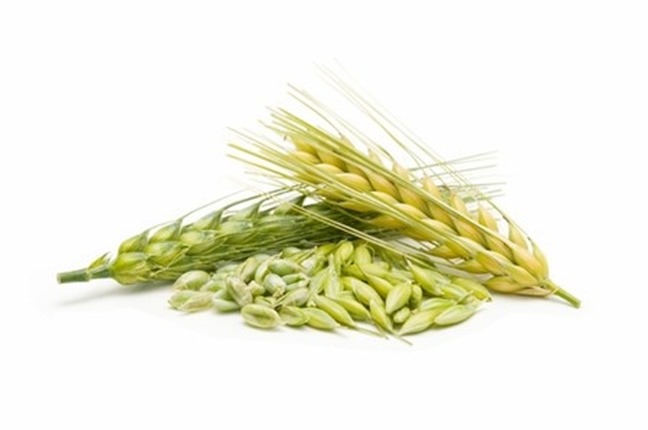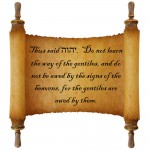 We have written a few articles on the Feasts of Passover and Unleavened bread. During the days of Unleavened bread, there is another feast day that is generally forgotten. This is mostly because it is not a day of rest and there is also no temple, so it is impossible to bring the required sacrifices. However, this is a very significant, prophetic, feast, which was fulfilled when Y’shua became the first fruit of the dead.
We have written a few articles on the Feasts of Passover and Unleavened bread. During the days of Unleavened bread, there is another feast day that is generally forgotten. This is mostly because it is not a day of rest and there is also no temple, so it is impossible to bring the required sacrifices. However, this is a very significant, prophetic, feast, which was fulfilled when Y’shua became the first fruit of the dead.
This day also marks the beginning of the counting of the Omer which leads to the next feast, the feast of weeks or Shavuot, 50 days later. The purpose of this article is to go into some more detail regarding this day, especially when it is to take place. There is some disagreement on this among believers. Some say that we are to celebrate the feast of First fruits on the day after the first day of unleavened bread, like Judah does. Others, like ourselves interpret the instructions to celebrate this day on the day after the weekly Sabbath. So, what are we to do? Which interpretation is correct?
Did you know that this is not a new debate? This difference in interpretation already existed before the time of Y’shua. The Sadducees interpreted it as being the day after the weekly Sabbath, contrary to the Pharisees, who understood it to be on the day after the first day of Unleavened bread. We shall go into a bit of history to see who these two groups were and also attempt to search out who’s interpretation was followed in the days when Y’shua was on earth.
We have learned from a previous study that Y’shua kept the calendar of the Temple. Now we need to find out which of these two interpretations they followed. We shall first look at the instructions in Scripture.
The Feast of First fruits
Leviticus 23:10-13
10 Speak to the sons of Israel and say to them, When you enter the land which I am going to give to you and reap its harvest, then you shall bring in the sheaf of the first fruits of your harvest to the priest. 11 He shall wave the sheaf before YHVH for you to be accepted; on the day after the sabbath the priest shall wave it. 12 Now on the day when you wave the sheaf, you shall offer a male lamb one year old without defect for a burnt offering to YHVH. 13 Its grain offering shall then be two-tenths of an ephah of fine flour mixed with oil, an offering by fire to YHVH for a soothing aroma, with its drink offering, a fourth of a hin of wine.
Let us break this down a bit.
Who is to observe this feast?
From the text we learn that this is to be observed by the “sons of Israel”
1201 I. n.masc.; Str 1121; TWOT 254 1. LN 10.14 10.48 child, i.e., the immediate offspring of a parent, either male or female (Ge 3:16), see also domain LN 9.41 9.45; 2. LN 10.14 10.48 son, i.e., the immediate male offspring of a parent (Ge 4:25); 3. LN 9.46 9.48 son, i.e., a term of endearment for persons with a relationship, as a figurative extension of the love of a parent for a child (Jos 7:19); 4. LN 4.1 4.37 offspring, foal, i.e., the male offspring of an animal (Zec 9:9); 5. LN 10.14 10.48 grandchild, i.e., the offspring of a parents child, of either sex, though usually male (Ge 31:28); 6. LN 10.14 10.48 descendant, progeny, i.e., the offspring of an ancestor, of any of a number of generations (Lev 6:11[EB 18]); 7. LN 9.1 9.23 person, formally, son, i.e., person which is of a class or kind, often used in combinations with other nouns (Lev 19:18), see also domain LN 58.21 58.30; 2
This phrase “the sons of Israel” is often used in Scripture. However, it does not only refer to the men of Israel, but all of Israel. Most other translations have it as Israel or the people of Israel.
We have learned that we are a part of Israel, so this is for us. So, are we to bring this first fruit offering? The answer is no, the reason being the absence of the Temple. YHVH has commanded offers to be brought at the place where He chose to put His name. What else is significant about this feast?
It marks the time when the harvest can be eaten
Leviticus 23:14
14 Until this same day, until you have brought in the offering of your Elohim, you shall eat neither bread nor roasted grain nor new growth. It is to be a perpetual statute throughout your generations in all your dwelling places.
This is a very important point to remember and is closely related to the barley being in the aviv stage before the new year is declared. We have written a previous article about this titled “Is the search for abib barley scriptural?“ Barley in the aviv/abib stage takes about two weeks to ripen adequately in order to be harvested. It is therefor logical that the barley needs to be at the aviv stage in order for the new year to begin because two weeks later is the Feast of Passover, Unleavened bread and First Fruits. No bread or roasted grain or new growth was to be eaten until this day. Not having a Temple where this offer can be brought makes it impossible to observe this, however, we can still celebrate this day and check the barley to make sure our calendar stays in sync with the agricultural cycle.
This is important because the feasts are intricately connected with the agricultural cycle. If we chose our own markers, we will end up celebrating the feasts at the wrong times.
Let’s now look at the prophetic significance of this feast. We have written a previous article about it “The significance of understanding First Fruits.“ We will, therefor, just briefly touch on this.
The prophetic fulfillment of the Feast
The Spring feasts have been fulfilled and the Feast of First Fruits in no exception. Y’shua fulfilled this feast by being the first fruits of the dead. He was resurrected on the day after the Sabbath.
1 Corinthians 15:20
20 But now Messiah has been raised from the dead, the first fruits of those who are asleep.
1 Corinthians 15:23
23 But each in his own order: Messiah the first fruits, after that those who are Messiah’s at His coming,
The Greek word “aparche” is translated as first fruits.
569 (aparchē), n.fem.; DBLHebr 8040, 9556; Str 536; TDNT 1.484. LN 53.23 first portion, firstfruits (as an offering to God), (Ro 11:16; Rev 14:4+)2
When was Y’shua resurrected from the dead?
Mark 16:1-2
1 When the Sabbath was over, Mary Magdalene, and Mary the mother of James, and Salome, bought spices, so that they might come and anoint Him. 2 Very early on the first day of the week, they came to the tomb when the sun had risen.
The Sabbath spoken of here is the weekly Sabbath, when you read the rest of the verse it is written, “on the first day of the week.” Y’shua rose after the weekly Sabbath, on the first day of the week. It was also prophesied that He would be in the earth three days and three nights. Remember, when Y’shua was asked for a sign, He said he gave them the sign of Jonah. We have previously written about this “Y’shua in prophecy – The sign of Jonah” So, in order for Y’shua to fulfill all these prophecies, He must have died on the day of Passover, being without leaven or sin, and He must have remained in the grave three days and three nights. Thereafter, in order for Him to fulfill the Feast of First fruits, being the first fruits of the dead, He must have been resurrected on the first day of the week, which He was.
Carefully consider this and keep it in mind as you read further.
When is the feast of First Fruits?
So, now the burning question; when exactly is the feast of first fruits? We have answered this question already in a way in the previous section, but will elaborate here. We were not given a specific date for the feast of First Fruit or the following feast, the feast of Shavuot. These two feasts are linked in two ways. Both are feasts of ingathering or first fruits; the feast of first fruits is for barley and the feast of Weeks or Shavuot is for wheat. The other connection is in the timing of the Feast of Weeks. This feast is celebrated on the fiftieth day after the feast of First Fruits. Let’s just take a look at when this counting is to be started and ended, for it also tells us when we are to observe both feasts.
Leviticus 23:11
11 He shall wave the sheaf before YHVH for you to be accepted; on the day after the sabbath the priest shall wave it.
The Scripture reads that it is to take place the day after the Sabbath. Which Sabbath is this? Before we answer this, we need to look at the rest of the instructions. As we said, these instructions also relate to the counting of the Omer.
The counting of the Omer
Leviticus 23:15-16
15 You shall also count for yourselves from the day after the sabbath, from the day when you brought in the sheaf of the wave offering; there shall be seven complete sabbaths. 16 You shall count fifty days to the day after the seventh sabbath; then you shall present a new grain offering to YHVH.
If you were to count fifty days from the first day of the week, you will always have a fiftieth day on the first day of the week; the day after the seventh Sabbath. This is easy to understand and do. 
However, if we were to count the first day of Unleavened bread as the first Sabbath, we will always be celebrating First Fruits on the 6th of Sivan. Why would YHVH give an instruction to count the days if the feast was always on the 6th of Sivan? This would also not fall on the day after the Sabbath, but on any day of the week. This interpretation would be breaking scripture.
This is, by the way, also the way the Sadducees understood and practiced it. Remember this as we continue.
The counting of the Omer in the time of Y’shua
You may be wondering; what did Y’shua do? When did He and His disciples observe Shavuot or according to which interpretation did they count the Omer? We must remember two very important things about Y’shua. Firstly, He kept the commandments of YHVH.
Matthew 5:17- 19
17 Do not think that I came to abolish the Law or the Prophets; I did not come to abolish but to fulfill. 18 For truly I say to you, until heaven and earth pass away, not the smallest letter or stroke shall pass from the Law until all is accomplished. 19 Whoever then annuls one of the least of these commandments, and teaches others to do the same, shall be called least in the kingdom of heaven; but whoever keeps and teaches them, he shall be called great in the kingdom of heaven.
And secondly, He came to fulfill Scripture as we have seen in the section about the prophetic significance of this feast as well as countless other times.
We have also learned in a previous article “Which calendar did Y’shua follow” that Y’shua followed the calendar of the Temple. So how was this Scripture interpreted and observed by the Temple authorities? Who was in authority at the Temple?
Before we can attempt to answer these questions, we need to look into the different sects that existed in the time of Y’shua and what their roles were. The two main groups were the Sadducees and the Pharisees. There was also another group, the Essenes, and we will tell you more about them in our next article.
Who were the Pharisees?
PHARISEES Aramaic, Perishaya; Hebr. Perushima: Party representing the religious views, practises, and hopes of the kernel of the Jewish people in the time of the Second Temple and in opposition to the priestly Sadducees. They were accordingly scrupulous observers of the Law as interpreted by the Soferim, or Scribes, in accordance with tradition. No true estimate of the character of the Pharisees can be obtained from the New Testament writings, which take a polemical attitude toward them (see NEW TESTAMENT), nor from Josephus, who, writing for Roman readers and in view of the Messianic expectations of the Pharisees, represents the latter as a philosophical sect. 3
Let us now look at the other group, the Sadducees.
Who were the Sadducees?
The Sadducees were essentially aristocrats. They virtually dominated the higher echelon of the priesthood, and many Sadducees who were not priests held positions of authority as lay elders in the Sanhedrin. Thus the difference between the Sadducees and the Pharisees was not a simple one of priests versus laymen (many Pharisees were also priests”mostly of the lower ranks, but probably some even in the upper levels). Rather, the Sadducees derived their power from their class, while the Pharisees derived theirs from learning (HJP2, II, 404). Indeed, Josephus characterized the Sadducees as men of the highest standing (Ant. xviii.1.4 [17]). As a result of their high social status the Sadducees were dominated by political interests, and in these areas they were rigidly conservative, it naturally being in their best interest to maintain the status quo. Maintaining the status quo necessarily entailed collaboration with the Roman occupiers, by whom their power was delegated, and for this self-serving policy the masses despised the Sadducees. The Sadducees strict policies of law and order, described as heartless or savage (Ant. xx.9.1 [199] in contrast to the leniency of the Pharisees (xiii.10.6 [294]), appeased the Romans and kept the Sadducees in power. Understandably they found any popular movement threatening, especially if it had political overtones as in the frequent messianic uprisings. In this light Y’shua’s statements about a Kingdom (and Himself as king in any sense) would have been alarming to the Sadducees (cf. the exchange between the chief priests and Caiaphas the high priest in 11:48-50). On the other hand, if Y’shua’s teaching was understood as a call for radical changes in life-style and for justice in the public arena (see Cassidy, pp. 52-54, 114-121), His claims could hardly have been less acceptable to the Sadducees.
The Sadducees concern to maintain their position of power may in part explain their rejection of oral tradition. As priests they insisted on exercising their prerogative of interpreting the Torah, and they accepted as binding only the laws and regulations recorded in Scripture. Thus they did not accept as authoritative the Pharisees oral law (Ant. xiii.10.6 [296f]). In fact, students were even encouraged to dispute with their own Sadducean teachers about the interpretation of the law (Ant. xviii.1.6 [167]).4
What were the interpretations of the Pharisees and Sadducees?
We have touched on this before.
Now we know how both these sects interpreted the Scripture. We now need to find out whose interpretation was followed. Who was the High priest at the time of Y’shua? From Scripture, we learn that it was Annas and/or Caiaphas.
Annas and Caiaphas, the High Priest
Annas was the father-in-law of Caiaphas and was still very influential even after Caiaphas became the high priest. In Luke we find a reference to “the high priesthood of Annas and Caiaphas.
Luke 3:2
2 in the high priesthood of Annas and Caiaphas, the word of Elohim came to John, the son of Zacharias, in the wilderness.
We also see this strong influence when Y’shua was first interrogated by Annas and then by Caiaphas.
John 18:13
13 and led Him to Annas first; for he was father-in-law of Caiaphas, who was high priest that year.
You may wonder where we are going with this. You see, in Acts chapter five there is reference to the High Priest being of the sect of the Sadducees.
Acts 5:17
17 But the high priest rose up, along with all his associates (that is the sect of the Sadducees), and they were filled with jealousy.
The book of Acts started off where the Gospels ended, after Y’shua was taken up to heaven. Caiaphas was still the High Priest then.
Acts 4:6
6 and Annas the high priest was there, and Caiaphas and John and Alexander, and all who were of high-priestly descent.
Taking the timing of the book of Acts into account, we know that the high priest spoken of here is the same high priest who was in authority at the time of Y’shua. This was Caiaphas and as we have learned, he was a Sadducee. Consider this, would a high priest of the sect of the Sadducees submit himself to the traditions of the Pharisees? Would he follow the Pharisaic interpretation of the counting of the Omer or that of the Sadducees? What do you think?
Here are some more references confirming that Caiaphas was a Sadducee.
The followers of the Sadducean party, compared with those of their rival sect, were few in number; but this was counterbalanced by their superior influence. Their opinions, observes Josephus, were received by few, yet by those of the greatest dignity (Ant. xviii. 1. 4). At this period, the most influential men among the Jews were probably Sadducees. It is even probable that the high priests Annas and Caiaphas belonged to this sect. Luke, when relating another hostile attack of the hierarchy on the apostles, says, The high priest arose, and all they that were with him, which is the sect of the Sadducees (Acts 5:17); and Josephus expressly asserts that a son of Annas, of the same name, and afterwards high priest, was a Sadducee (Ant. xx. 9. 1).6
The Sadducees were very influential, maybe the most influential in the Sanhedrin at this time.
Ssan hee’ drihn) The highest Jewish council in the first century. The council had 71 members and was presided over by the high priest. The Sanhedrin included both of the main Jewish parties among its membership. Since the high priest presided, the Sadducean priestly party seems to have predominated; but some leading Pharisees also were members (Acts 5:34 ; Acts 23:1-9 ).7
Now, when we read about the history of the Jewish people as portrayed by Josephus and Philo, we find that they seem to have a conflicting view. Why is that?
Josephus and Philo
Philo was a philosopher who was the father of both Gnosticism and Kabbalism and Josephus a historian. It is important to note that both Josephus and Philo were Pharisees and presented the ideas of the Pharisees when they wrote about the Jewish people.
He did not write, “how it was observed, but how it is to be observed” It is most probable that he gave a Pharisaic interpretation of the commandments.
Both Philo and Josephus wrote that the feast of First fruits took place on the 16th day of Aviv, the day after the first day of unleavened bread. This is in line with the traditional pharisaic interpretation. Should we take their writings as authority over what is written in Scripture, knowing that they themselves held a traditional Pharisaic view which was opposing to what is written in Scripture.
Also, consider that Josephus lived in Rome and Philo in Alexandria. Were they really writing a first hand account of what was done at the time in Jerusalem?
There has also been many inaccuracies found in both the works of Josephus and Philo since the discovery of the Dead Sea Scrolls that prove that they were not infallible. Josephus, for example wrote a very detailed account of what happened at Masada without being there. Where did he get all this detailed information from if only two women is said to have survived. They were hidden so they could not have seen what took place. Makes you wonder what really happened there.
We are not trying to discredit Josephus, his writings are very valuable to us, but we are to be careful not to believe everything we read and are not to use it to prove our doctrine especially if it is contrary to Scripture.
Further proof
In the book “Biblical Calendars” J. van Goudoever wrote the following ” The conclusion is that the struggle about the omer-counting which existed between the Pharisees and the Sadducees in Jerusalem also occurred in Samaria between the Docithaeans and the Sebuaeans. It is remarkable that both in Jerusalem and Samaria the priests counted the 50 days from sunday to sunday. It is not likely that the Samaritan priests borrowed their counting of the omer from the Boethusian(Sadducean) priests in Jerusalem, or that the Boethusians borrowed theirs from the Samaritans. Both traditions could have been independent of each other, but it is more probable that both groups preserved an older calendar practice.”
This quote further proves that the omer was counted from sunday to sunday in Jerusalem.
Conclusion
We have learned from Scripture when we are to celebrate the feast of First Fruits as well as when to start the counting of the Omer. It is very easy to understand when you read all the scripture in context. The Feast of First Fruits takes place on the first day of the week after the beginning of the feast of Unleavened bread, and this starts the counting of the Omer for the Feast of Weeks (Shavuot). This Feast takes place fifty days later, on the first day of the week, after the seventh Sabbath.
We can also conclude that we are to follow Y’shua in what we do. He came as an example for us, He fulfilled the Scripture, including this feast. We are His disciples, and are to walk as he walked. He observed the Torah of YHVH without compromise; He did not follow the majority, who were the Pharisees; He condemned them for teaching as commandments the traditions of men. Would He then follow their tradition and celebrate an appointed time of YHVH on the wrong day?
History tells us that the High Priest was a Sadducee at the time of Y’shua and they did not follow the same traditions the Pharisees did; the Sadducees followed the literal interpretation of the Scripture. They were also the majority, and most influential in the Sanhedrin. There already, we have enough evidence, in our opinion, that the correct interpretation of this commandment was observed.
Then we have Josephus and Philo, both Pharisees, who wrote about the observance of the Torah. Can we be absolutely sure that they were not writing in accordance to their own beliefs as they did on many other occasions?
We presented you with the Scriptural and extra-biblical evidence. You be the judge for yourself what you are to follow. This is what Y’shua had to say about that
Matthew 15:9
9 But in vain do they worship Me, Teaching as doctrines the precepts of men.
Always seek truth!
2 Timothy 2:15
15 Be diligent to present yourself approved to Elohim as a workman who does not need to be ashamed, accurately handling the word of truth.
References
- All quoted passages are from the New American Standard Bible: 1995 Update. LaHabra, CA: The Lockman Foundation, 1995. We have substituted YHVH for LORD and Y’shua for Jesus.
- Swanson, J. (1997). Dictionary of Biblical Languages with Semantic Domains : Hebrew (Old Testament). Oak Harbor: Logos Research Systems, Inc.
- Singer, I. (Ed.). (1901–1906). In The Jewish Encyclopedia: A Descriptive Record of the History, Religion, Literature, and Customs of the Jewish People from the Earliest Times to the Present Day, 12 Volumes. New York; London: Funk & Wagnalls.
- Moulder, W. J. (1979–1988). Sadducees. In (G. W. Bromiley, Ed.)The International Standard Bible Encyclopedia, Revised. Wm. B. Eerdmans.
- Wiersbe, W. W. (1996). The Bible exposition commentary (Vol. 1, p. 338). Wheaton, IL: Victor Books.
- Gloag, P. J. (1870). A Critical and Exegetical Commentary on the Acts of the Apostles (Vol. 1, p. 141). Edinburgh: T&T Clark.
- http://www.studylight.org/dic/hbd/view.cgi?number=T5477
- Josephus, F., & Whiston, W. (1987). The works of Josephus: complete and unabridged. Peabody: Hendrickson.









Leave a Reply to David Cancel reply